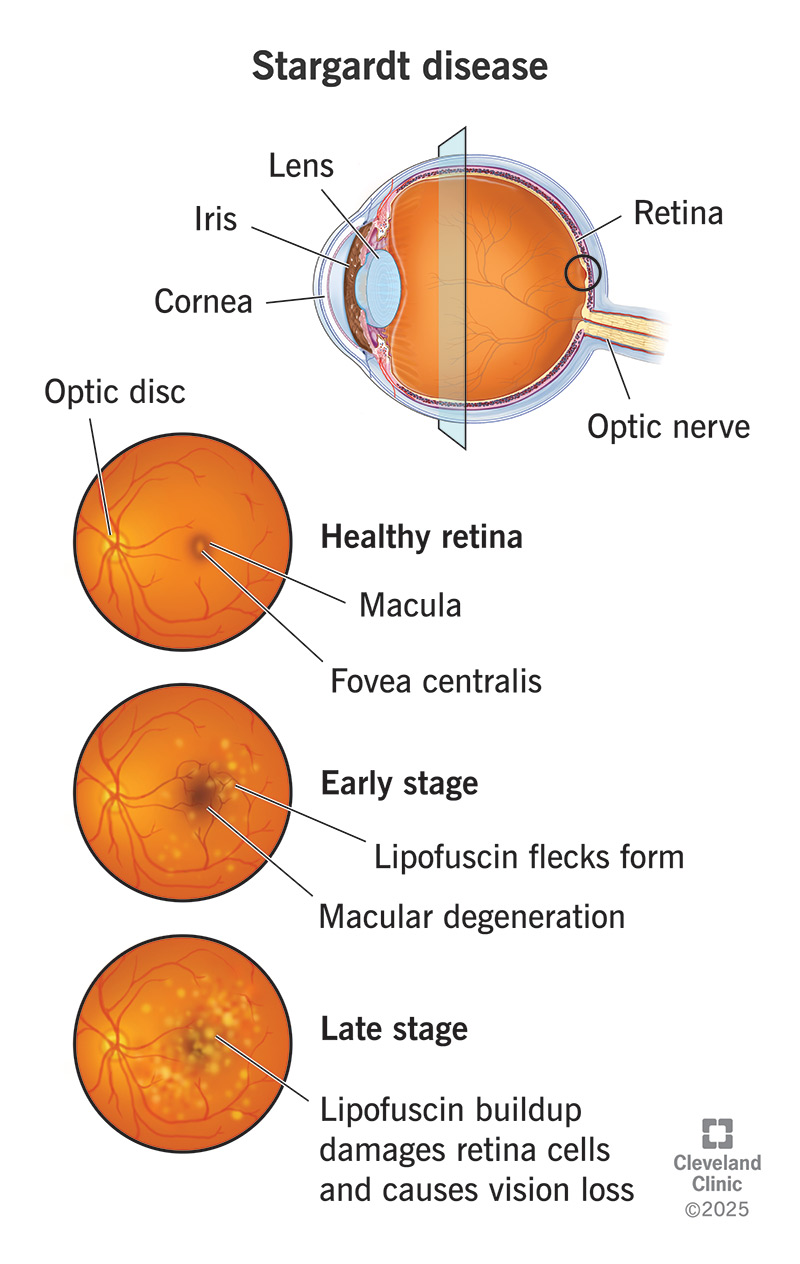Stargardt disease is a genetic condition that damages the macula in your eye. Over time, the damage reduces or eliminates your ability to see what’s right in front of you. There’s no treatment that can reverse Stargardt disease. But your eye doctor will suggest ways to protect your eyes and manage symptoms.
Advertisement
Cleveland Clinic is a non-profit academic medical center. Advertising on our site helps support our mission. We do not endorse non-Cleveland Clinic products or services. Policy

Stargardt disease is an eye condition that affects the macula and side parts of the retinas in your eyes. The macula is the part of your retina that lets you see objects directly in front of you (your central vision). Stargardt disease makes you lose your central vision over time. It can also affect your peripheral vision.
Advertisement
Cleveland Clinic is a non-profit academic medical center. Advertising on our site helps support our mission. We do not endorse non-Cleveland Clinic products or services. Policy
Stargardt disease is a type of macular degeneration. Most people with macular degeneration develop it later in life (after age 60). This is called age-related macular degeneration. Stargardt disease usually affects children and adults younger than 20. That’s why healthcare providers sometimes call it juvenile macular degeneration or juvenile macular dystrophy. It’s also known as fundus flavimaculatus when it affects the edges of your retina.
Stargardt disease happens when your body can’t get rid of a fatty yellow pigment called lipofuscin. If you have Stargardt disease, your body makes too much of it. The extra lipofuscin collects in your retina. It damages special cells called photoreceptors. Eventually, the damage permanently affects your vision.
Stargardt disease will cause noticeable changes in your eyes and vision, including:
Stargardt disease symptoms are usually progressive. This means they get worse over time. Eventually, you’ll lose some or all of your central vision. You might still be able to see out of the sides of your eyes. But you won’t be able to clearly see objects directly in front of you.
Advertisement
Stargardt disease is a genetic condition. It happens when there’s a genetic change in the ABCA4 gene. This gene helps your retinas work correctly.
Stargardt disease is hereditary. Biological parents pass it to their children. Stargardt disease is passed through families in an autosomal recessive pattern. That means both biological parents need to have a changed ABCA4 gene for their biological children to develop Stargardt disease.
An eye doctor will diagnose Stargardt disease. They’ll give you an eye exam to check your vision and eye health. Tell your provider when you first noticed changes in your vision or other symptoms.
You might need a few tests, including:
Your eye care specialist may classify Stargardt disease with stages as it progresses, including:
There’s no treatment to reverse Stargardt disease or the damage it causes. Your eye care specialist will suggest ways to manage symptoms and slow down the vision loss, including:
Your eye care specialist can help you manage Stargardt disease, but you can’t cure it.
Researchers are conducting clinical trials to find ways to treat all types of macular degeneration (including Stargardt disease). Ask your eye care specialist if you’d be a good fit for a clinical trial. This can help you get access to new, experimental treatments.
Visit a healthcare provider or eye care specialist as soon as you notice any changes in your eyes or vision. Stargardt disease can share symptoms with other, more common conditions. It’s important to get any eye issue diagnosed as soon as possible.
You should expect to lose your central vision. Most people experience vision loss slowly over several years. It sometimes takes decades. But it can happen faster. How your ABCA4 gene is changed can affect how quickly you lose your vision. This can also control how much of your vision you lose. Your eye doctor will help you understand what to expect.
Advertisement
You’ll need regular eye exams to monitor changes in your eyes. Ask your eye care specialist how often you should schedule routine exams and any follow-up tests.
You can take care of yourself in many ways by eating a nutritious diet and getting enough exercise. Don’t smoke. Deal with stress as it comes. Keep your regular schedule of appointments with your healthcare providers.
Your eye care specialists will want to see you on a regular basis. Make sure you keep those appointments. However, if you have any changes in vision or any type of pain, you should contact your provider right away.
Here are some questions you may want to ask your provider if you have Stargardt disease:
Living with Stargardt disease can be scary. Anything that affects your vision is. But your eye care specialist will help you adjust to changes in your sight over time. They’ll suggest ways to protect your eyes and help you feel safe and comfortable.
There isn’t a cure for Stargardt disease now, but researchers are always looking for new treatments. Ask your provider about participating in a clinical trial if you’re interested.
Advertisement
Your eyes are one of your most important senses. If something goes wrong, it can change your world. Cleveland Clinic can help treat all types of retinal disease.

Last reviewed on 05/02/2025.
Learn more about the Health Library and our editorial process.